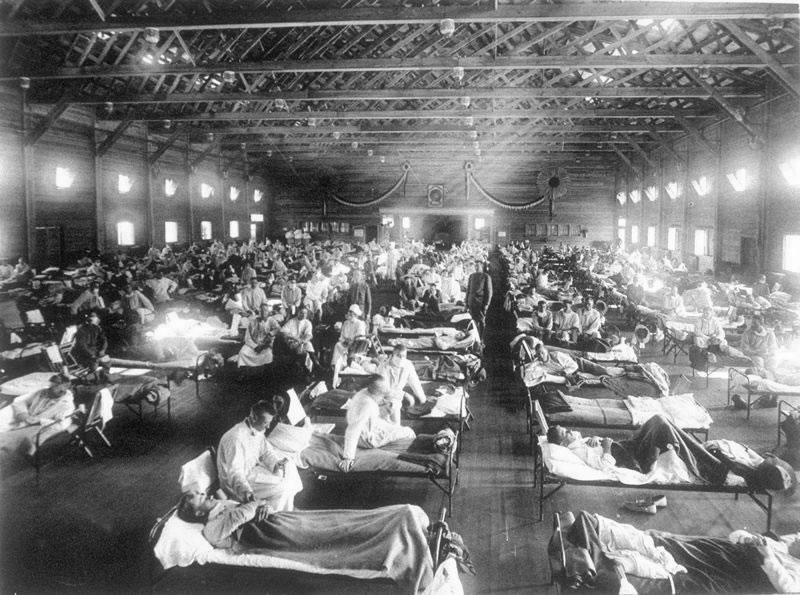Thousands of American soldiers were returning home, the war was over and the Germans had lost. Whilst the men fought against each other, many were subject to very bad conditions in the trenches created for trench warfare. As men spent hours, days, even months in atrocious conditions in the trenches, many acquired diseases not seen before. Rats would be bigger, faeces would be scatted, along with blood, and other noxious elements.
The flu came as a surprise, with many thinking it was just a common cold. Nobody had expected a virus to kill approximately 16 million people in the course of less than a year, and the virus killed fast, but as more and more soldiers came back from the war, many Americans grew weary that the soldiers were bringing the disease with them from Europe.
 |
| Ill soldiers at a hospital ward at Camp Fuston, Kansas |
Many think the virus came from British military camps in the north and was brought into Spain by French trains. After the Spanish newspaper, ABC, made its headline of an unknown disease appearing in the streets of Madrid, the misconception grew of the virus originating in Spain, although a great deal of evidence proves other wise, the name has stuck.
 |
| Public Health Service announcement |
Throughout 1918 -1919, the virus managed to kill 1 percent of the U.S.' population, although the American president, Woodrow Wilson, did try to prevent the spread onto even more Americans by closing down many public spaces, and cancelling many mass gatherings, such as parades. Though the government did take many precautions to stop the spread of the influenza, the virus was spreading fast and the great war had left many countries with short medical supplies. Millions of lives were at steak and the virus was not stopping. Cities in the U.S. were so badly hit, the city of Philadelphia was ravaged by the plague that many children became orphaned, the government couldn't do much to help them.
The virus had no cure, and state governments were passing strict laws, laws restricting spitting, and with many cities forcing their citizens to wear gauze masks, though such precautions would unfortunately fail as the virus could still penetrate through the masks.
The influenza would not begin to disappear until the end of 1919, when the Public Health Service had finally began to report that influenza cases were in decline. There were more than 700,000 Americans left dead, and thousands more orphaned or widowed, the death toll in the U.S. reached up to 1 percent of the country's total population. Globally, estimates say more than 21 million people died as a result of the disease.
Sources:
https://virus.stanford.edu/uda/
http://cid.oxfordjournals.org/content/47/5/668.full
http://www.flu.gov/pandemic/history/1918/
This is an interesting look at one of the most devastating epidemics we've had. I wonder how the precautions taken by the U.S. you mentioned to prevent the flu (closing public spaces, cancelling parades, etc.) affected Wilson's campaign for the League of Nations in America. Obviously, this was not one of the main factors in America's rejection of the Treaty of Versailles, but do you think it contributed?
ReplyDeleteStatistics such as these provide a tangible sense of the staggering loss of life that occurred in many cities throughout thw U.S. Philadelphia during this short period, though tell us next to nothing about how influenza inflicted widespread fear and distress across the city. For an instant in the fall of 1918 it was as if Philadelphia had been transported back to the fourteenth century to that grisly time when victims stricken with plague were often found dead within twenty four hours of contracting it.
ReplyDeletehttp://philadelphiaencyclopedia.org/archive/influenza-spanish-flu-pandemic-1918-19/
the*
ReplyDeleteIt is horrifying to see that we assumed that there were only two periods of mass death in the 20th century, WW1 and then WW2. The Spanish Flu killed millions. Additionally, it was apparently called the Spanish Flu because Spain was the only one to cover it in depth. Other countries censored their news and reporters and as a result, only uncensored, neutral Spain was able to fully investigate the flu and got the name.
ReplyDeletehttp://www.history.com/topics/1918-flu-pandemic
I find it so interesting that modern day, people don't connect the Spanish Flu pandemic with the H1N1 that just a few years ago killed a handful of people and scared the whole nation. Yet when you put it into perspective the Spanish Flu killed millions, and the H1N1 hadn't even killed 100 people.
ReplyDelete